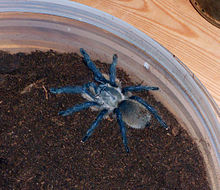
Huntsman spiders, members of the family Sparassidae, are known by this name because of their speed and mode of hunting. They catch their prey by hunting rather than in webs. They are also called giant crab spiders because of their size and appearance. Larger species sometimes are referred to as wood spiders, because of their preference for woody places. In southern Africa the genus Palystes are known as rain spiders or lizard-eating spiders. Commonly, they are confused with baboon spiders from the Mygalomorphae infraorder, which are not closely related.

Atypidae, also known as atypical tarantulas or purseweb spiders, is a spider family containing only three genera. They are accomplished ambush predators that spend most of their time in a sock-like, silken retreat on the ground from where they kill their prey.

Wasps in the family Pompilidae are commonly called spider wasps, spider-hunting wasps, or pompilid wasps. The family is cosmopolitan, with some 5,000 species in six subfamilies. Nearly all species are solitary, and most capture and paralyze prey, though members of the subfamily Ceropalinae are kleptoparasites of other pompilids, or ectoparasitoids of living spiders.
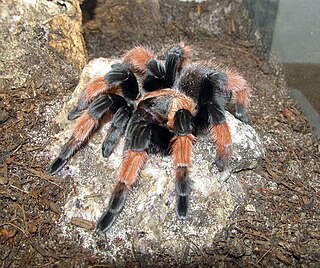
Brachypelma is a genus of spiders in the family Theraphosidae (tarantulas). They may have bodies up to 6 cm long with legs of similar or greater lengths. Some species have brightly colored legs, with red or orange marks and rings.
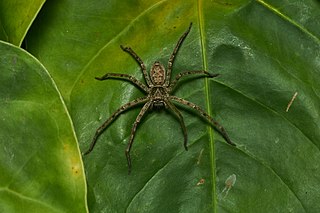
Heteropoda venatoria is a species of spider in the family Sparassidae, the huntsman spiders. It is native to the tropical regions of the world, and it is present in some subtropical areas as an introduced species. Its common names include giant crab spider, pantropical huntsman spider or cane spider.

Previously placed in the genus Avicularia, C. versicolor is native to Martinique in the Caribbean Sea.

Pterinochilus murinus or the orange baboon tarantula, is a nocturnal spider in the family Theraphosidae that was first described in 1897 by Reginald Innes Pocock. This species is found in Angola, as well as central and southern Africa. It is a member of the subfamily Harpactirinae, baboon spiders.

Enoplognatha ovata, the common candy-striped spider, is a species of spider belonging to the family Theridiidae. Their scientific name derives from the latin word 'ovatus' which means egg-shaped. Despite its small size, this is a formidable predator which can prey on insects many times its size.
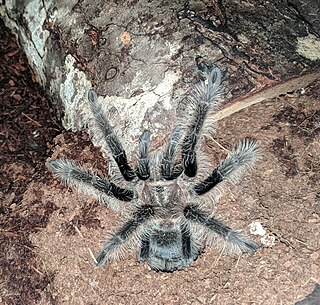
Tliltocatl albopilosus is a species of tarantula, also known as the curlyhair tarantula. The species' native range is Costa Rica. They are largely terrestrial, opportunistically burrowing spiders.

Tarantulas comprise a group of large and often hairy spiders of the family Theraphosidae. As of December 2023, 1,100 species have been identified, with 166 genera. The term "tarantula" is usually used to describe members of the family Theraphosidae, although many other members of the same infraorder (Mygalomorphae) are commonly referred to as "tarantulas" or "false tarantulas". Some of the more common species have become popular in the exotic pet trade. Many New World species kept as pets have setae known as urticating hairs that can cause irritation to the skin, and in extreme cases, cause damage to the eyes.
Hysterocrates gigas is a member of the tarantula family, Theraphosidae found in Cameroon. It is known as the giant baboon spider, Cameroon red baboon spider, or red baboon tarantula.

Psalmopoeus cambridgei, the Trinidad chevron tarantula, is a species of spider in the family Theraphosidae, endemic to Trinidad. Its venom is the source of psalmotoxin and vanillotoxin which are classified as inhibitor cystine knot proteins. Psalmotoxin may be of therapeutic use in patients with a stroke.
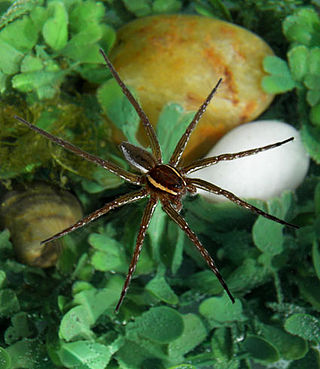
The six-spotted fishing spider is an arachnid from the nursery web spider family Pisauridae. This species is from the genus Dolomedes, or the fishing spiders. Found in wetland habitats throughout North America, these spiders are usually seen scampering along the surface of ponds and other bodies of water. They are also referred to as dock spiders because they can sometimes be witnessed quickly vanishing through the cracks of boat docks. D. triton gets its scientific name from the Greek mythological god Triton, who is the messenger of the big sea and the son of Poseidon.

Psalmopoeus irminia, also known as the Venezuelan suntiger, is a species of tarantula endemic to Venezuela, Guyana and Brazil. They were first described in 1994 by F. Saager.

Aphonopelma anax, commonly known as the Texas tan tarantula, is a species of spider belonging to the family Theraphosidae native to southern Texas and northern Mexico.

Monocentropus is a genus of tarantulas that was first described by Reginald Innes Pocock in 1897. As of March 2020 it contains three species, found on Madagascar and in Yemen: M. balfouri, M. lambertoni, and M. longimanus.

Heteroscodra maculata is an Old World species of tarantula which was first described in 1899 by Reginald Innes Pocock. This species native to West Africa and is found primarily in Togo and Ghana. This species has many common names, of which Togo starburst and ornamental baboon are most frequently encountered.

Harpactira pulchripes, also known as the golden blue-legged baboon spider, is a bright yellow-bodied and metallic blue-legged tarantula found in South Africa. It was first described by Reginald Innes Pocock in 1901. It is a very highly desired tarantula in the European and American tarantula keeping hobby. Its specific name pulchripes is derived from Latin "pulchri" meaning beautiful, and "pes" meaning feet, forming the name beautiful feet.
Eucratoscelus pachypus also known as the Tanzania stout leg baboon tarantula or the stout leg tarantula, was first described by Gunter Schmidt and Volker von Wirth in 1990. It is found in Tanzania, hailing from arid parts, and is an obligate burrower.

Harpactira cafreriana otherwise known as the Cape copper baboon or amber baboontarantula spider was first described by Charles Athanase Walckenaer in 1837. It is found in South Africa, being terrestrial or semi-fossorial in nature.
